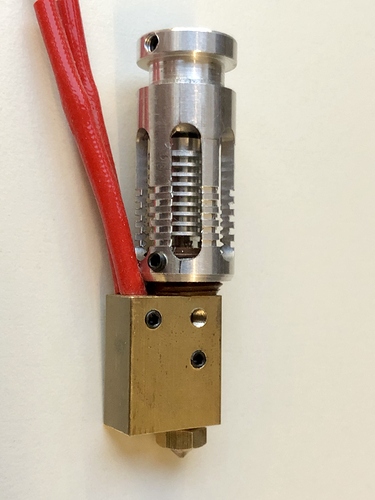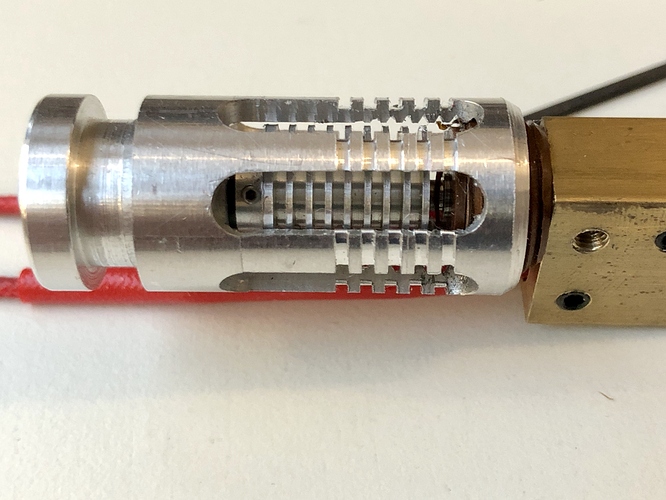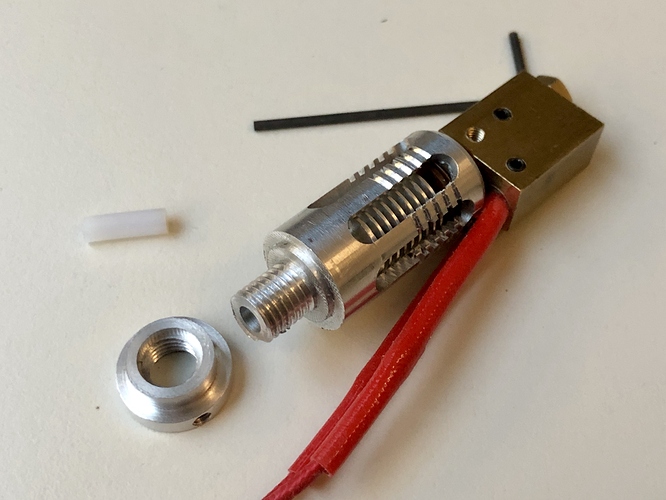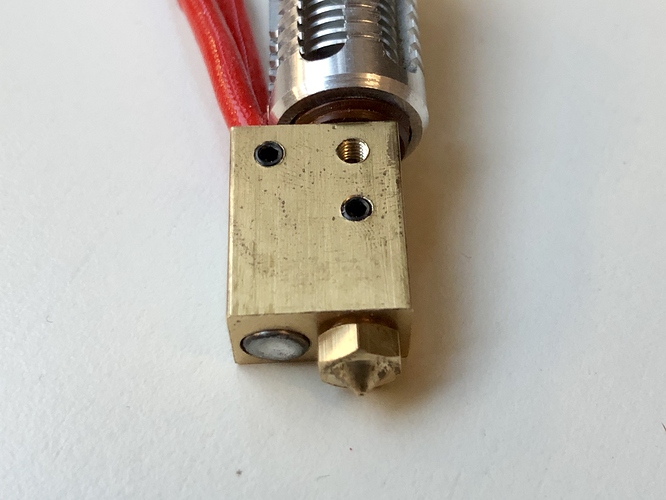Closeups of the new J-Head 12 HiFlow from http://hotends.com.
That looks like fancy expensive machining that only blocks airflow. That heatbreak is also not ideal method of doing it. Thin SS 303 tube is the way to go.
@Shai_Schechter maybe you should read the specifications before you post such an opinion. As per the description of this hotend inside the connection between heater block and top is 0.011" thin. That should block almost all heat creep.
@Hakan_Evirgen I have and by looking at the picture itself, you can see a brown colored part that is in contact with the heater block and heatsink. Presumably PEEK material. That is a lot of surface contact with heater, which would transfer a lot of heat to the heatsink, regardless if it’s PEEK. It may work for PLA, but as you get into more exotic materials, it will not work well. I know this, because we’ve designed hotends as well and there’s a good reason why E3D and others don’t have such a bulky connection between heatsink and heater block.
That DOES seem like a weird, expensive, and fragile way to do it.
I like the vertical heater orientation, makes the cable management easier, though reducing the printing volume for me.
On a side note, why nobody using the filament injection from the side? That would maximize the Z volume and allows to mount the radiator away from the rising hot air.
First print with the J-Head MK12 and PETG filament:
@Alex_Koukarine aside from more complex hot block machining, right turns in the filament path make the melt pool bigger (small harm to print quality) and add hot end back-pressure (harder to extrude at high rates) and keep you from doing stuff like cold-pull nozzle cleaning and ram-purge color changes.
Stratesys has older hot end designs with a gradual 90 degree turn inside bent steel tubing, and the E3D cyclops has two turns in each filament path… it works but has downsides, so you typically don’t see it unless there’s a really good reason.
@Ryan_Carlyle Kinda makes sense. Even though I forgot the last time I did the cold pull that single maintenance operation may counter any better cooling benefits (if any, actually) for some. Cyclops seems to be working even with two turns! So at least that’s not a physics’ limitation. Googling for an aluminum brick to try it out.
@Alex_Skoruppa Looks GREAT!! I still have yet to install mine - sitting on the bench. I see you still went with a fan though…does it NEED one??
@Shai_Schechter as per the description the hotend 100% Metall. So the brown part may be just a reflection or something else.
@Alex_Skoruppa tell us more about thos hotend please.
@Hakan_Evirgen Actually it only says that the filament path is all metal, other parts could still be PEEK or even higher performing polymers.
The outer aluminum heatsink screws into the heater block. It supports the heater block. Then inside there is either an airgap or very thin tube going from the heater block to the inner heatsink.
Very complicated just to make a transition zone. Just use a titanium heartbreak.
A lightsaber in the making 
So hows it going with this so far?
On the product page it says “Max Operating Temperature: 285°C (limited by insulator - higher temps available soon)”
So it’s almost certainly a PEEK insulator. Seems weird, but definitely a large cross-sectional area for the heat break.
My guess is that the transition zone is actually just above that insulator - between the insulator and the first fin of the aluminum.
If that’s the case, it could still be a sharp transition.
Just not sure what this does that a volcano doesn’t aside from a different form factor…
The designer said it’s something else, I forget the name of it. PEEK doesn’t sustain that temp very well. It seems regular all-metal hot ends generally have that as their nominal limit anyway because you want to give some margin to thermistors too, until you switch to some other sensor.
@Jeff_DeMaagd realistically, much over 300C and your aluminum hot block starts to get too weak to be reliable with high melt zone pressures. Thermocouples work perfectly fine as hot as you could ever want to go, but the hot block will fail or leak at some point.
285C limit sounds like a perfluoro compound (eg PTFE or related).
Whatever it is, it’s a plastic, and the limit is not due to thermistor range overhead.
They say they’ll be able to get hotter when there are new insulator materials available.
My guess is it’s a glass filled PEKK similar to PEEK, but has HDT of around 300C, and they’re using stainless surgical tubing as the heatbreak, thus the need for it to be screwed into the heater block because the tubing can’t handle any shear forces.






